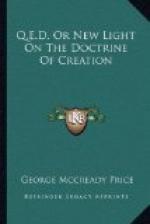All this means that many facts regarding the position of the strata as well as regarding their consolidation contradict the theory of successive ages.
2. Many of the rivers of the world completely ignore the alleged varying ages of the rocks in the different parts of their course, and treat them all as if of the same age or as if they began sawing at them all at the same time. This is true of the Rhine, the Meuse, and the Danube in Europe, the Sutlej of India, and the upper part of the Colorado in America, not to mention others. The old strand lines around all the continents act in the very same way, ignoring the varying ages of the rocks they happen to meet; as is also true of nearly all the great faults or fissures which are of more than local extent. The ore veins of the various minerals are about as likely to be found in Tertiary or Mesozoic as in the Palaeozoic. A very similar lesson is to be learned from the fossils found lying exposed on the deep ocean bottom; for they are about as likely to be Palaeozoic or Mesozoic as Tertiary.
From these facts we conclude that practically all the great natural chronometers of the earth seem to treat the fossiliferous rocks as if they are all of about the same age, completely disregarding the distinctions in age founded on the fossils.
3. According to the present chronological arrangement of the rocks, very many genera, often whole tribes of animals, are found as fossils only in the oldest rocks, and have skipped all the others, though found in comparative abundance in our modern world. Very many others have skipped from the Mesozoic down, while still others skip large parts of the series of successive ages.
These absurdities would all be avoided by acknowledging that the current distinctions as to the ages of the fossils are purely artificial, and that one fossil is intrinsically just as old or as young as another.
4. It is now known that any kind of “young” beds whatsoever, Mesozoic, Tertiary, or even Pleistocene, may be found in such perfect conformability on some of the very oldest beds over wide stretches of country that “the vast interval of time intervening is unrepresented either by deposition or erosion”; while in some instances these age-separated formations so closely resemble one another in structure and in mineralogical make-up that, “were it not for fossil evidence, one would naturally suppose that a single formation was being dealt with” (McConnell); and these conditions are “not merely local, but persistent over wide areas” (A. Geikie), so that the “numerous examples” (Suess) of these conditions “may well be cause for astonishment” (Suess).
A still more astonishing thing from the standpoint of the current theories is that these conformable relations of incongruous strata are often repeated over and over again in the same vertical section, the same kind of bed reappearing alternately with others of an entirely different “age,” that is, appearing “as if regularly interbedded" (A. Geikie) with them, in a manifestly undisturbed series of strata.




